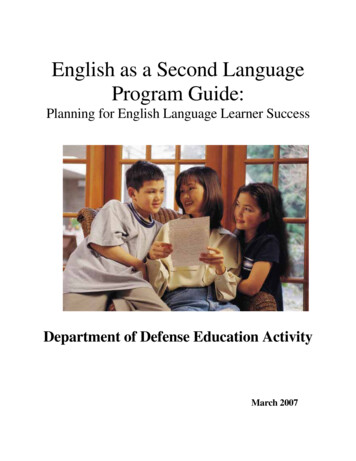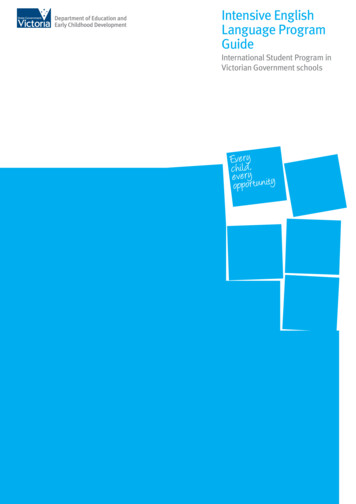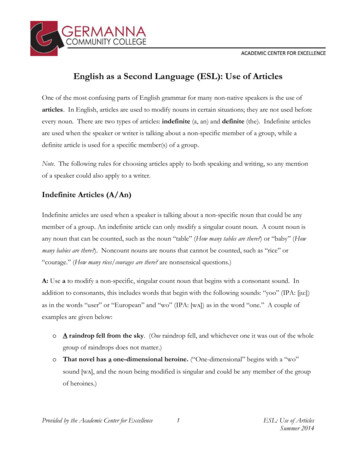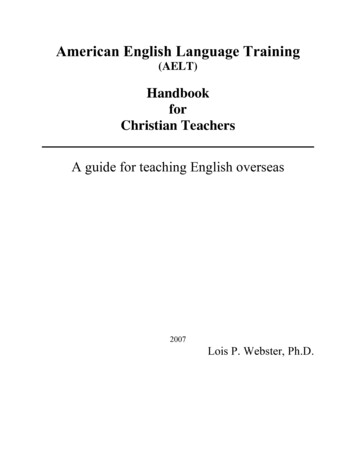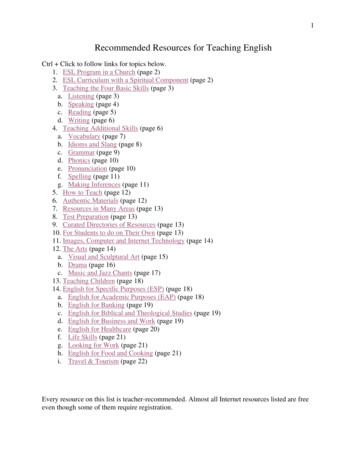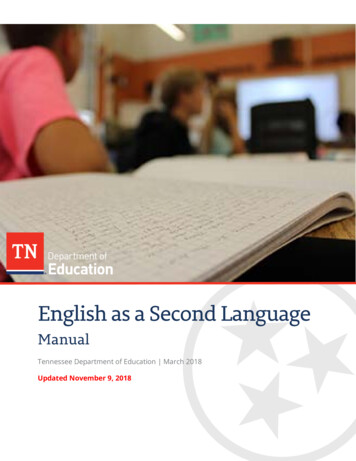
Transcription
English as a Second LanguageManualTennessee Department of Education March 2018Updated November 9, 2018
ContentsCONTENTS. IINTRODUCTION.4BACKGROUND .4CHAPTER 1: WELCOMING NEW STUDENTS .6WELCOMING NEW STUDENTS AND PARENTS .6STEPS IN THE REGISTRATION PROCESS .6STUDENT DATA .9ADDITIONAL ITEMS TO CONSIDER WHEN WELCOMING AN EL.10CHAPTER 2: IDENTIFYING ELS.11HOME LANGUAGE SURVEY .11IDENTIFICATION/PLACEMENT SCREENING ASSESSMENTS .12PARENTAL NOTIFICATION AND APPROVAL .13ASSESSING ELS FOR SPECIAL NEEDS .15ASSESSING ELS FOR INTELLECTUAL GIFTEDNESS .16ASSESSING ELS FOR ADDITIONAL SERVICES .17CHAPTER 3: EL SCREENER ASSESSMENTS .18W-APT AND WIDA SCREENER ASSESSMENT TO IDENTIFY ELS .18W-APT AND WIDA SCREENER PREPARATION .19W-APT AND WIDA SCREENER ADMINISTRATION .19W-APT/WIDA SCREENER SCORES AND NEXT STEPS .21CHAPTER 4: PLACING ELS.23PLACING ELS AT ALL GRADE LEVELS .23AWARDING TRANSFER CREDITS .23CHAPTER 5: ESL PROGRAM MODELS.25SERVICE DELIVERY PROGRAM MODELS .25PROGRAM MODELS OVERVIEW.25PROGRAM PLACEMENT EXAMPLES .28CHAPTER 6: PROVISIONING OF SERVICES FOR ELS .30CLASSROOM INSTRUCTION.30INDIVIDUAL LEARNING PLAN .32CHAPTER 7: WIDA STANDARDS .34WIDA STANDARDS FRAMEWORK.34WIDA CAN DO PHILOSOPHY .34AGE-APPROPRIATE ACADEMIC LANGUAGE IN SOCIOCULTURAL CONTEXTS .35ENGLISH LANGUAGE DEVELOPMENT (ELD) STANDARDS .36CHAPTER 8: ACCESS AND ANNUAL ASSESSMENTS .38i
ESSA REQUIREMENTS .38WIDA ACCESS FOR ELS 2.0.39PROFICIENCY LEVELS AND INSTRUCTIONAL SUPPORTS .39PROFICIENCY LEVEL ABILITIES .44ALTERNATE ACCESS FOR ELS .44MODEL.45STATE ASSESSMENTS FOR ELS .45ASSESSMENT ACCOMMODATIONS FOR ELS .46STATE-APPROVED EL ACCOMMODATIONS- TNREADY/EOC.49STATE-APPROVED EL ACCOMMODATIONS- ACCESS FOR ELS 2.0.49ADMINISTRATIVE NOTES .50DATA AND MONITORING .50CHAPTER 9: EXITING ELS AND GRADE RETENTION .51EXIT CRITERIA.51TRANSITIONAL YEARS .51CONSIDERATIONS WHEN EXITING ELS .52RECOMMENDED PROCEDURES FOR TRANSITIONAL ELS .53TRANSITIONAL EL ACHIEVEMENT DATA .54SPECIAL CONSIDERATIONS FOR EL RETENTION .55RESEARCH ON THE IMPACTS OF GRADE RETENTION.55ALTERNATIVES TO RETENTION .56CHAPTER 10: ADMINISTRATIVE REQUIREMENTS .57REQUIREMENTS FOR STATE FUNDING.57TITLE III FUNDING .57RESPONSIBILITIES OF DISTRICT PERSONNEL .58ESL TEACHER LICENSURE STANDARDS .59STAFFING RATIOS .61EL TEACHER ENDORSEMENTS.61CHAPTER 11: PRIVATE SCHOOLS .63TITLE III SERVICES.63STATUTORY & REGULATORY REQUIREMENTS .64APPENDIX A: RESOURCES .66APPENDIX B: GLOSSARY .69APPENDIX C: EIS CODING.71APPENDIX D: FEDERAL LEGISLATION AND SUPREME COURT RULINGS PROTECTING ELS .72FEDERAL LEGISLATION .72COURT RULINGS .74FEDERAL ENFORCEMENT POLICY .76STATE BOARD OF EDUCATION ESL PROGRAM POLICY (3.207) .77TITLE VI COMPLIANCE AND GRIEVANCE PROCEDURES .77APPENDIX E: CANDIDATE CONTENT STANDARDS .79ii
CITATIONS.82iii
IntroductionSince 2011, there has been a 45 percent increase in the English learner (EL) population acrossTennessee, and the EL population is continuing to grow. The purpose of this manual is to providesupport for Title I and Title III directors as they manage English as a Second Language (ESL) programsand projects. It also provides meaningful support for teachers and administrators who are working toimprove outcomes for ELs.With the reauthorization of the Every Student Succeeds Act (ESSA) in Dec. 2015 and subsequentapproval of Tennessee’s ESSA state plan, Tennessee is poised to leverage the increased state-leveldecision making authority, as well as flexibilities for programs to fulfill the vision laid out in Tennessee’sstrategic plan, Tennessee Succeeds. Tennessee’s vision is that that “districts and schools in Tennessee willexemplify excellence and equity such that all students are equipped with the knowledge and skills tosuccessfully embark upon their chosen path in life.” It is imperative that this vision is true for allstudents, including ELs.Questions and concerns regarding this document should be sent to Jan.Lanier@tn.gov,Katie.Barcy@tn.gov, or Joann.Runion@tn.gov. Assessment issues that relate to World-class InstructionalDesign and Assessment (WIDA) ACCESS, W-APT, MODEL, or any Tennessee Comprehensive AssessmentProgram (TCAP) assessments should be addressed to Lori.Morris@tn.gov.BackgroundThe U.S. Department of Education (ED) defines an EL as “[an individual] who comes from anenvironment where a language other than English has had a significant impact on the individual’s levelof English language proficiency [ and] whose difficulties in speaking, reading, writing, or understandingthe English language may be sufficient to deny the individual: the ability to meet the state’s proficient level of achievement on state assessments, the ability to successfully achieve in classrooms where the language of instruction isEnglish, or the opportunity to participate fully in society.” 1Students classified as ELs are entitled to services specifically designed to improve their Englishproficiency, which is needed for ELs to access the Tennessee Academic Standards. In Tennessee, analternative language program for ELs, known as English as a Second Language (ESL), is defined as,“English instruction especially designed for speakers of other languages.” 2Districts are federally mandated to identify all ELs, determine their English proficiency level, and provideeffective ESL programs. A complete list of federal legislation and Supreme Court rulings protecting ELscan be found in Appendix D.Effective ESL programs must be provided to all students identified as ELs in order to increase theirEnglish language proficiency. Under ESSA, all ELs are expected to meet the same academic standards astheir non-EL peers. Therefore, should a parent waive the EL child’s right to ESL services, the district mustprovide such services in the general education classroom.4
Tennessee state board policy 3.207 is designed to set minimum standards for Tennessee school districtsin providing services to non-English language background (NELB) students who are also ELs. In Oct.2017, the state board updated the policy to include the requirements that (1) all teachers working withELs must be trained on the WIDA English language development standards, (2) tailored ESL services cannow be considered at a score of 3.5 (previously 3.6), and (3) beginning in 2018-19, all ELs will have anIndividual Learning Plan (ILP). These state board changes provide guidance on how ELs can besupported in a strong partnership between ESL and general education teachers.WIDA FrameworkSince March 2014, Tennessee has been a member of the WIDA consortium, a non-profit cooperativegroup promoting educational equity for English learners. Tennessee utilizes WIDA for both standardsand assessment. Beginning in 2015-16, Tennessee transitioned to the WIDA ACCESS assessment as theEnglish Language Proficiency Assessment (ELPA) for ELs. The WIDA standards framework contains fivecomponents, including: Can Do PhilosophyGuiding Principles of LanguageDevelopmentAge-Appropriate Academic Languagein Sociocultural ContextsEnglish Language DevelopmentStandards and PerformanceDefinitionsStrands of Model PerformanceIndicators5
Chapter 1: Welcoming New StudentsWelcoming New Students and ParentsA new student’s first impressions of a school set the tone for the rest of that child’s experience at theschool and in the district. They, and their parents, may be scared and uncertain of what lies ahead. Allschool staff and faculty who will be meeting new students and their families should be prepared to putthem at ease with welcoming smiles and appropriate communication skills.In addition to introducing the student and his/her family to school personnel, it may be helpful toprovide them with the following information: pertinent bus/transportation information; meals available at the school, their cost, and how to register for free and reduced price lunch; school calendar and bell schedules, including daily start and end times; and school attendance policies, including tardiness.Steps in the Registration ProcessA consistent registration process for ELs facilitates their entry and orientation into the new schoolenvironment. It is vital to this orientation process to have school personnel who are trained anddedicated to meeting the needs of students from different cultures with different levels of Englishproficiency. School personnel should take the following steps to ensure a smooth transition:1. Greet the parents and student warmly;2. Complete a student profile form with the student’s personal data, language background, andeducational history. This should include the Home Language Survey (HLS) if one has not beenpreviously completed for the student (Information on the HLS can be found in Chapter 2:Identifying ELs.);3. Make copies of student records (e.g., transcripts, birth certificate, legal documents, etc.); and4. Screen the student for ESL services if the HLS determines they are NELB and there is noindication in their records that they have been exited from such services.If the district has access to documents from the referring state/school regarding the student’s previousESL status and/or proficiency level (e.g., W-APT, HLS, etc.), these may be used to expedite the enrollmentprocess.[NOTE: The school cannot turn a student away if the student doesn’t have school records from theirhome country. 3 The student must be enrolled in the grade closest to his/her age, and the school can tryto obtain the school records after the student is enrolled.A district must meaningfully communicate all material information to parents who have limited Englishproficiency. For example, when communicating with these parents about enrollment, the district shouldformally translate or interpret documents and have some method of responding to those parents’questions. 46
Material information could include any and all alternative means to establish proof of age and residencyrequirements. If a district requests a social security number, material information would also coverinforming the parents that a district cannot deny enrollment to a student if he/she (or his/her parents)chooses not to provide a social security number.]Cumulative Folder ChecklistA student’s cumulative folder should be created for each EL and kept at the school. The cumulativefolder should include the following: HLS Intake data for ELs: o Country of birtho Date arriving in a U.S. schoolo First languageo Any available documents (e.g., birth certificate, I-94, other immigration documents, etc.)o W-APT scoresEnglish Language Proficiency (ELP) assessment scores for all years served in ESL, if applicable Notes from IEP meetings, if applicableProtecting Student Privacy RightsTo comply with federal civil rights laws, as well as the mandates of the U.S. Supreme Court, 5 districts andtheir personnel may not request information with the purpose or result of denying access to publicschools on the basis of race, color, or national origin. Additionally, students must not be barred fromenrolling in public schools at the elementary and secondary levels based on the actual or perceivedimmigration or citizenship status of the student, or that of their parents/guardians.A district must apply its rules and standards for requested documentation in the same way toeveryone. 6Districts CANNOT require a student’s: birth certificate,social security number (or other documents related to immigration status),full medical records, orproof of residency to be established with their parent’s state-issued documents.Districts CAN: ask for a student’s birth date,assign a unique student identification number to students who do not provide a social securitynumber,require a student’s immunization records for the state and district requirements, andestablish a student’s residency within a district through multiple means.7
Social Security NumbersDistricts may request, but cannot mandate, that enrolling students provide a social security number. Asnoted above, a district may assign a unique student identification number (USID) to students who do notprovide a social security number. 7If a district chooses to request a student’s social security number, it must be made clear in all enrollmentand registration documents—including forms, websites, and communications with parents—that theprovision of the student’s social security number is voluntary and that choosing not to provide a socialsecurity number will not bar a child’s enrollment. 8Immunization RecordsA district may only require a student’s immunization records for state and district immunizationrequirements; state immunization requirements can be found here. 9 A district should not send parentsand children home to retrieve the documents as a prerequisite to register.[NOTE: For students who have not received all required immunizations, a school must schedule animmediate appointment with the school nurse, a public health clinic, or an appropriate healthcareprovider.]Proof of ResidencyDistricts should use a variety of documents to establish proof of residency within district limits to allowany resident to meet the stated requirements. As with establishing the age of a child, the district shouldpublicize that these options are acceptable for all children in the district and used solely to establishproof of residency.Examples of accepted documentation of a student’s residency within a district include, but are notlimited to, the following: rent receipt, lease for dwelling, utility bill, doctor’s bill, or notarized affidavit from a neighbor.[NOTE: An emancipated minor is to be enrolled in the district for which he/she is zoned based onhis/her own address, not that of his/her parents.]Establishing Student AgeDistricts are encouraged to take proactive steps to educate parents about their children’s rights and toreassure them that their children are welcome in district schools. A variety of documents are permittedto establish the age of an enrolling child. Districts should publicize that these options are acceptable forall children in the district and are solely used to establish the child’s age.8
Examples of accepted documentation of a student’s age include, but are not limited to, the following: birth certificate, passport, other immigration document, or notarized affidavit.[NOTE: The district may have to accept a verbal report of the student’s age from the parent of thestudent.]Parental RightsParents have the right to be informed of: 10 the reasons for the identification of their child as an EL and the need for placement in an ESLprogram; their child’s level of English language proficiency, how levels are assessed, and the status of theirchild’s academic achievement; the method of instruction used in the ESL program in which their child is, or will be, participating;oIf multiple ESL programs are available in the district, information must be provided onhow the programs differ in content and instruction goals. how the ESL program in which their child is, or will be participating in, will meet the educationalstrengths and needs of the child; how the ESL program will specifically help their child learn English and meet age-appropriateacademic achievement standards for grade promotion and graduation; the specific exit requirements for the ESL program, the expected rate of transition of ELs fromESL programs into general education classrooms, and the expected rate of graduation fromsecondary school; in the case of a child with a disability, how the ESL program meets the objectives of theindividualized education program (IEP) of the child; and the options that parents have to decline to enroll their child in the ESL program or to chooseanother program or service delivery model, if more than one program or model is offered by thedistrict.Student DataOnce a student has been identified as an EL, districts should maintain the following information for anystudent identified as an EL for their individual student profiles. Assessment information (e.g., standardized tests taken, scores, and dates) Academic information (e.g., courses taken, grades, attendance, and promotion/retention) Entry date into U.S. schools Entry date into the district Years of schooling in the student’s home language9
Educational historyoInterrupted education? – Yes/No Testing for vision and hearing Physical or psychological conditions that may affect learning Classroom observations by teachers Enrollment history and criteria used for placement in special services (e.g., ESL, speech therapy,special education, intellectual giftedness, etc.)[NOTE: Should the student qualify for ESL services, he/she will be coded as “L” in the district studentinformation system (SIS) for English language background. If the student does not qualify, based onrequired screener results, he/she will be coded as “N” in the SIS for English language background.Districts must make sure that students are appropriately coded in the SIS system and that datauploaded to the Education Information System (EIS) is accurate.]Additional Items to Consider When Welcoming an ELSchool TourTake the student and their family on a tour of the school and introduce them to the people who will beimportant in the student’s academic journey. This should include their classroom teacher, ESL teacher,and guidance counselor.Peer BuddyAssign a “peer buddy” to help the student adjust during his/her first few days at the new school. Thebuddy can come from the ESL program or student organizations and should be prepared to guide thenewcomer to classrooms, the lunchroom, locker facilities, the restrooms, and other locations in theschool. The buddy may also help make introductions to other students.Additional Suggestions for High School StudentsIn order to meet graduation requirements, additional steps should be considered when incoming highschool ELs arrive to a school, such as: providing the student and his/her family with a chart explaining the requirements for graduationand the policies regarding required and elective subjects; explaining the schedule of standardized tests and how they impact the student’s progress; explaining semester grading periods and progress reports; explaining how grades and course credits—including transfer credits—are awarded; and reviewing all foreign transcripts.10
Chapter 2: Identifying ELsHome Language SurveyThe Home Language Survey (HLS) is the first step districts take to meet the federal requirement toidentify language minority students. 11 The department requires a student to be administered a HLS onertime in their educational career upon12their initial enrollment.Administer the HLS to Determine the Student's Home LanguageA Tennessee HLS must include thefollowing three questions:1. What is the first language thischild learned to speak?r2. What language does this childspeak most often outside ofschool?3. What language do peopleusually speak in this child’shome?Districts may ask for additionalinformation, as needed. This is theappropriate time for the district todiscuss education with parents (e.g.,milestones in early childhood, formereducation, interruptions to education,learning difficulties, traumatic events,etc.).The HLS should not be included in thedistrict/school’s registration packet thata parent fills out to enroll their child.The HLS should be given to the parentas a separate document that isthoroughly explained to them so theyunderstand its purpose. All completedsurveys must be filed in the student’scumulative folder and transferred withthe folder if the student transfers. 13If the student is transferring fromanother school, the original HLS shouldbe obtained. If a language other thanEnglish was indicated, there should bedocumentation of the student’s priorEnglish language proficiency1. What is the first language this child learned to speak?2. What language does this child speak most often outside of school?3. What language do people usually speak in this child's home?\.rIf all three responsesare "English," screeningis not required.\." rrlIf one or more response(s) indicatea language other than English,administer the W-APT or WIDAScreener (depending on grade levelof student)\.iIf the student scores:K (1st semester) 27 orbelow on composite; orK (2nd semester) 27 orbelow on composite; 14or below on reading; or17 or below on writing;orGrade 1-12 below 4.5on composite or 4.0 orbelow on any domain,the student requires ESLservices.The student is coded as Lin EIS.\." .r"' !"'IIf the student scores:K (1st semester) above27 on composite; orK (2nd semester) above27 on composite; above14 on reading; or above17 on writing; orGrade 1-12 4.5 orabove on composite orabove 4.0 on alldomains, the student isnot eligible- for ESLservices.The student is coded as Nin EIS.\. 11
assessment(s) in his/her cumulative folder. The student’s instructional program should followaccordingly.[NOTE: In order to ensure that responses given on the HLS are accurate and legally binding, districtsshould make every attempt to administer this document in the home langua
alternative language program for ELs, known as English as a Second Language (ESL), is defined as, “English instruction especially designed for speakers of other languages.” 2 . Districts are federally mandated to identify all ELs, determine their English proficiency le


